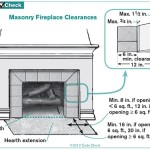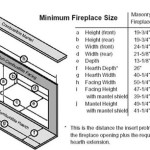Installing A Wood Burning Fireplace: Understanding the Costs
The installation of a wood-burning fireplace can transform a house into a home, providing warmth, ambiance, and a focal point for gatherings. However, understanding the costs involved is crucial before embarking on such a project. The expense of installing a wood-burning fireplace is variable, influenced by several factors including the type of fireplace desired, the existing structure of the home, labor costs in the area, and any necessary upgrades to ensure safety and compliance with local building codes.
This article aims to provide a comprehensive overview of the cost considerations associated with installing a wood-burning fireplace, addressing the various elements that contribute to the overall price tag. From the initial purchase of the fireplace unit to the final inspection, a thorough understanding of these factors will empower homeowners to make informed decisions and budget effectively.
Key Point 1: Fireplace Type and Associated Costs
The type of wood-burning fireplace selected significantly impacts the overall cost. There are primarily three types to consider: prefabricated fireplaces, fireplace inserts, and traditional masonry fireplaces. Each option offers different advantages and disadvantages, influencing both the initial investment and long-term operational expenses.
Prefabricated fireplaces, also known as zero-clearance fireplaces, are factory-built units designed to be installed within a framed enclosure. They are generally less expensive than masonry fireplaces and offer greater flexibility in terms of placement within the home. The cost of a prefabricated fireplace unit can range from $1,000 to $5,000, depending on the size, features, and aesthetic design. Installation costs typically involve framing, venting, and connecting to the chimney system, potentially adding another $1,000 to $3,000 to the total cost. These fireplaces are easier and quicker to install compared to masonry options, reducing labor costs.
Fireplace inserts are designed to be installed directly into an existing masonry fireplace opening. They are an efficient way to upgrade an existing fireplace, improving heating efficiency and reducing emissions. The cost of a wood-burning fireplace insert can range from $2,000 to $6,000. Installation typically involves preparing the existing fireplace opening, connecting the insert to the chimney liner, and ensuring proper sealing. This can add another $500 to $2,000 in installation costs, depending on the complexity of the existing fireplace and the specific requirements of the insert.
Traditional masonry fireplaces are built from the ground up using bricks, stones, or other masonry materials. They offer a classic and timeless look but are the most expensive option. The cost of building a masonry fireplace can range from $5,000 to $20,000 or more, depending on the size, design complexity, and materials used. This type of fireplace requires extensive labor and expertise, contributing to the higher cost. Furthermore, masonry fireplaces typically have lower heating efficiency compared to prefabricated options, potentially increasing long-term heating costs.
The material choices within each fireplace type also influence cost. For example, choosing premium stone for a masonry fireplace will significantly increase the price compared to using standard brick. Similarly, a prefabricated fireplace with intricate detailing and high-end finishes will be more expensive than a basic model.
Key Point 2: Chimney and Venting Requirements
A properly functioning chimney and venting system is crucial for the safe and efficient operation of a wood-burning fireplace. The cost associated with these components can vary significantly depending on whether an existing chimney is present and its condition, or if a new chimney needs to be installed. This is a significant element in determining the final "installing a wood burning fireplace cost".
If an existing chimney is present, a thorough inspection is necessary to ensure it is structurally sound and complies with current building codes. This inspection typically costs between $100 and $500. If the chimney is damaged or does not meet code requirements, repairs or a complete rebuild may be necessary. Chimney repairs can range from minor patching to relining the flue, with costs ranging from $500 to $5,000 or more, depending on the extent of the damage.
Chimney relining involves installing a new liner inside the existing chimney flue. This is often necessary to improve safety and efficiency, especially when installing a fireplace insert. The cost of chimney relining can range from $1,000 to $4,000, depending on the length of the chimney and the type of liner used (e.g., stainless steel or clay). A proper liner is essential to prevent dangerous gases from leaking into the home and to ensure proper draft for efficient combustion.
If a new chimney needs to be installed, the cost can be substantial. A prefabricated chimney system, which is commonly used with prefabricated fireplaces, can cost between $2,000 and $6,000 installed. This includes the cost of the chimney sections, connectors, and labor for installation. The cost of a masonry chimney can be significantly higher, potentially ranging from $4,000 to $10,000 or more, due to the materials and labor involved. Factors influencing chimney cost include height, location, and material.
Venting requirements also depend on the type of fireplace. Prefabricated fireplaces typically require a specific type of vent pipe that is designed to withstand high temperatures. The cost of this vent pipe can range from $50 to $200 per section. Proper venting is essential to ensure that smoke and combustion gases are safely expelled from the home.
Key Point 3: Labor and Installation Costs
Labor and installation costs represent a significant portion of the overall expense of installing a wood-burning fireplace. These costs can vary depending on the complexity of the installation, the location of the home, and the experience and qualifications of the contractor. Obtaining multiple quotes from qualified professionals is essential to ensure a competitive price.
The complexity of the installation is a primary driver of labor costs. Installing a prefabricated fireplace in a new construction home with pre-existing framing and venting may be relatively straightforward, resulting in lower labor costs. In contrast, installing a masonry fireplace in an existing home that requires extensive modifications to the structure can be significantly more expensive.
Geographic location also impacts labor costs. Labor rates tend to be higher in urban areas with a higher cost of living compared to rural areas. The availability of qualified contractors in the area can also influence prices. In areas with high demand for fireplace installers, prices may be higher due to the limited supply of skilled labor.
When obtaining quotes, it is crucial to inquire about the contractor's qualifications, experience, and insurance coverage. A qualified contractor should have experience installing wood-burning fireplaces and be familiar with local building codes. They should also be properly licensed and insured to protect homeowners from liability in case of accidents or damages.
Typical labor costs for installing a prefabricated fireplace can range from $500 to $2,000. Installing a fireplace insert can cost between $500 and $1,500, while building a masonry fireplace can incur labor costs ranging from $2,000 to $8,000 or more. These are just estimates, and actual costs may vary depending on the specific circumstances of each project. Some contractors may charge an hourly rate, while others may offer a fixed price for the entire project. Ensure to clarify the pricing structure before agreeing to any work.
Permits and inspections are also necessary parts of the installation process and contribute to overall costs. The cost of permits can range from $50 to $500, depending on the local jurisdiction. Inspections are required to ensure that the installation meets all applicable building codes and safety standards. These inspections can add another $100 to $300 to the final cost. Failing to obtain proper permits and inspections can result in fines and potential safety hazards.
Furthermore, consider the potential for unexpected costs during the installation process. Hidden structural issues, code violations, or unforeseen complications can arise, leading to additional expenses. It is advisable to set aside a contingency fund of approximately 10-15% of the total budget to cover such unexpected costs.

How Much Does Wood Stove Installation Cost 2024 Bob Vila

What Does It Cost To Install A Fireplace Vs Wood Stove Stamford Fireplaces

Wood Stove Installation Cost In 2024 Forbes Home

How Much Does Wood Stove Installation Cost 2024 Bob Vila

Woodburner Installation Costs Stove Hot Box Stoves

How Much Does Fitting A New Log Burner Cost In 2024 Bonfire

How Much Does It Cost To Install A Wood Burning Stove The Cosy Company

What S The Average Fireplace Installation Cost

Fireplace Installation Cost Toronto The

Log Burner Installation Cost Guide How Much Are Burners
Related Posts








